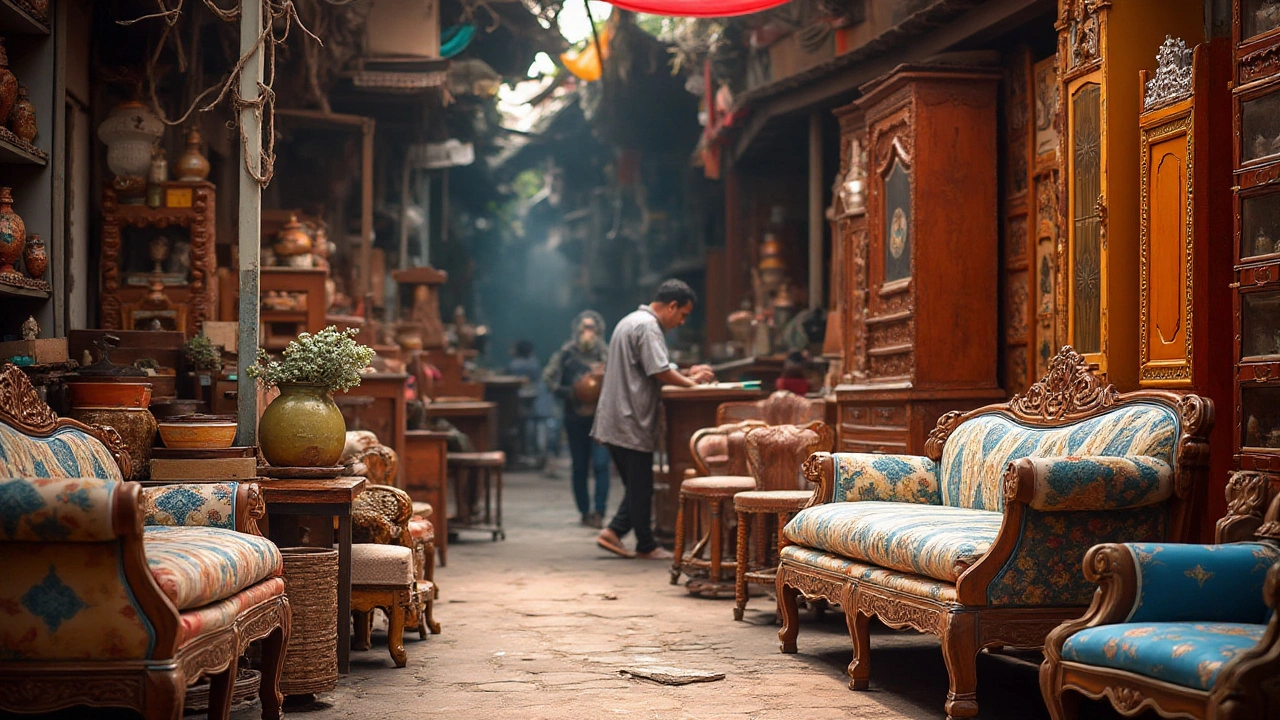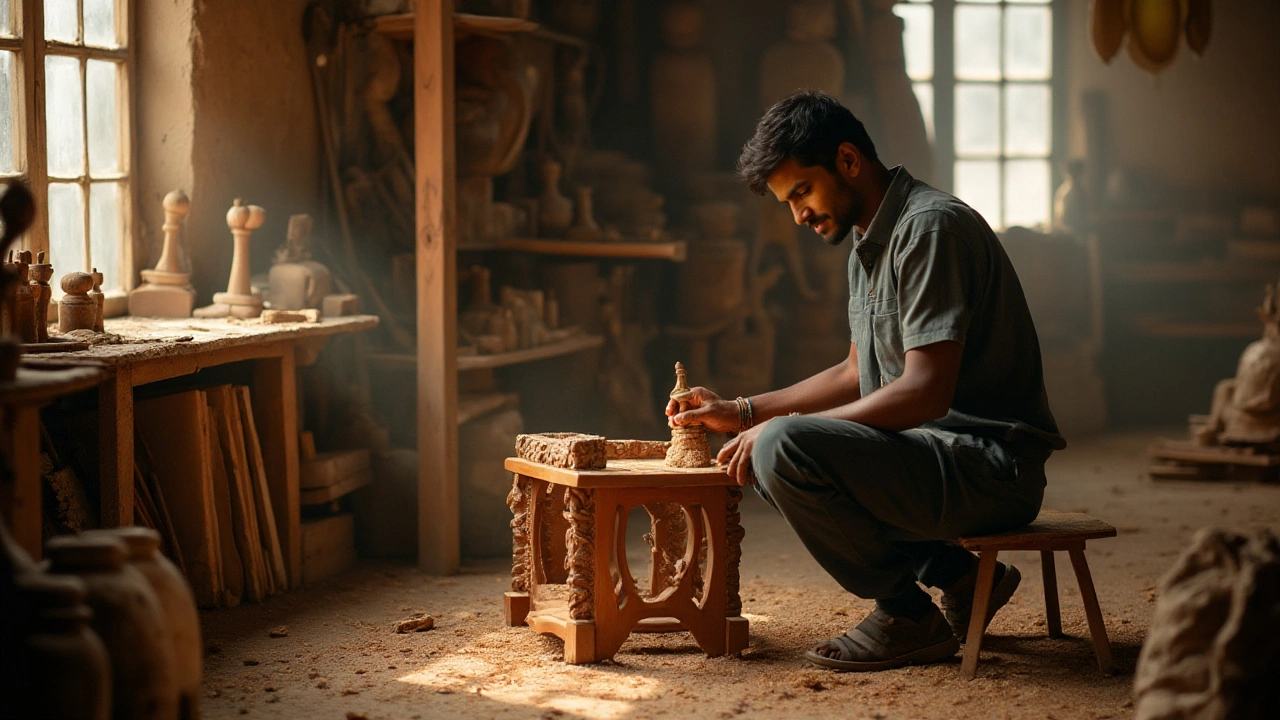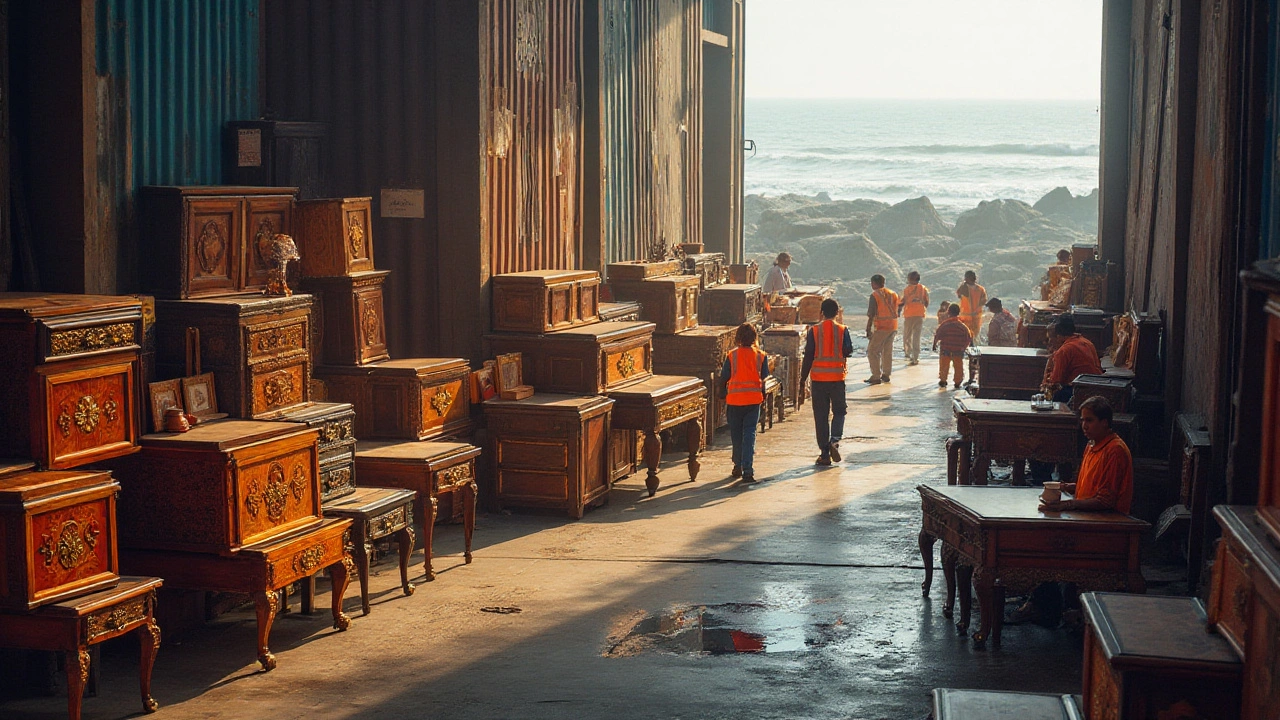Importing Furniture from India: Costs and Considerations

Diving into the world of importing furniture can unveil a realm of design possibilities, and India stands out as a promising source of exquisite craftsmanship. From handcrafted wooden pieces to intricate carvings, furniture manufacturers in India offer a variety of options that entice buyers globally. However, the financial layer involved in bringing these pieces overseas can be somewhat intricate.
Unpacking the costs associated with furniture importation from India requires understanding several components – each playing a distinct role in the final pricing. It's not just about the price tag of the furniture piece, but also the complex web of logistics, tariffs, and quality checks that accompany it. Whether you're furnishing a boutique hotel or adding charm to a residential project, aligning your budget with the reality of importation expenses is a crucial step.
This article aims to shed light on the multiple facets of importing furniture from India, providing insights and practical strategies to help navigate the process efficiently. From grasping the market dynamics to handling logistics, knowing what's involved will save time, reduce costs, and ensure quality results.
- Understanding the Indian Furniture Market
- Cost Breakdown of Furniture Importation
- Logistics and Shipping
- Quality Assurance and Standards
- Tips for Successful Importation
Understanding the Indian Furniture Market
The Indian furniture market is a rich tapestry woven with cultural heritage and modern designs, reflecting a diversity that caters to a wide range of tastes and preferences. Known for its vibrant craftsmanship, India's furniture industry combines traditional techniques with contemporary flair, appealing to both rustic aficionados and minimalist seekers. The array of materials used is vast, ranging from sturdy teak and sheesham to lightweight bamboo and cane. Each region in India often has a unique style—Rajasthan’s intricate carvings and Kerala’s elegant cane weaving are just a few examples that highlight the diverse offerings from Indian artisans.
The market is not just a playground for intricate designs but also a hub for high-quality furniture that stands the test of time. Many manufacturers in India focus on sustainable practices, employing eco-friendly materials and processes to minimize environmental impact. This attention to sustainability, without skimping on quality, makes Indian furniture appealing to eco-conscious consumers worldwide. As demand for unique and sustainable furniture grows, India's reputation on the global stage continues to rise.
One cannot ignore the economic advantage that India holds when it comes to manufacturing. The labor cost in India is significantly lower compared to Western countries, allowing international buyers to afford high-quality pieces at attractive prices. This economic aspect is crucial for retailers and designers looking to offer distinctive products without an exorbitant investment. According to industry reports, the Indian furniture market is expected to grow substantially in the coming years, driven by both domestic consumption and export demands. This growth trajectory underscores the importance of India as a key player in the global furniture industry.
Import furniture from India involves more than financial transactions; it requires understanding cultural and operational dynamics. Buyers often need to interact with manufacturers who might have a different pace or style of doing business. Patience and adaptability become essential traits here. A quote from the World Trade Organization highlights this well:
"Navigating international markets requires not just economic understanding but cultural empathy."Such insights emphasize the need for effective communication and relationship-building with Indian manufacturers, ensuring a smooth procurement process.
For those new to the Indian market, attending furniture expos like the India International Furniture Fair can provide valuable exposure. These events showcase the latest trends and innovations, allowing buyers to engage directly with manufacturers. Building these connections can be beneficial, as many smaller workshops and artisans might not have an online presence, yet offer exceptional quality and unique designs. Investing time in understanding the landscape can lead to rewarding partnerships and exclusive access to pieces that stand out in any collection.
Cost Breakdown of Furniture Importation
Importing furniture from India stands as a fascinating venture but requires meticulous financial assessment. At the heart of this journey is the alchemy of converting production costs into a shipped product ready to grace spaces thousands of miles away. Let's begin with the manufacturing costs. Manufacturers in India, renowned for powerful craft traditions and skilled workforce, offer competitive pricing. The cost of raw materials such as teak, rosewood, or mango wood can vary significantly, influenced by quality and current market trends. Labor pricing is generally favorable compared to Western standards, which can be a major draw for potential importers looking to maximize value.
Besides the base price from the manufacturers, several layers of expenses factor into the final cost. Shipping expenses represent a considerable portion, hinging on the size, weight, and volume of the furniture. Ocean freight is usually the primary mode of transport due to cost-efficiency for bulk orders, while air freight is reserved for urgent shipments. Understanding Incoterms (International Commercial Terms) is crucial in this regard, as they dictate the division of responsibilities and costs between sellers and buyers. Importers should be familiar with terms like CIF (Cost, Insurance, and Freight) which includes costs up to the destination port, or FOB (Free On Board) which covers costs up till the goods are loaded on the ship.
According to the World Trade Organization, understanding and negotiating Incoterms can drastically reduce unexpected costs.
Moreover, tariffs and duties are pivotal to the cost equation. These vary by product type, value, and importing country's policies, often adding a substantial overhead to the buying price. For instance, the U.S. Customs imposes different duty rates for wooden and upholstered furniture, sometimes hovering around 1% to 8%, respectively. Adequate research and the hiring of a competent customs broker can facilitate the navigation of these bureaucratic waters and ensure compliance with international trade laws.
A less-discussed yet crucial factor is insurance. Marine insurance prdouidness gants peace of mind against potential losses or damages during transit. Although optional, it becomes almost indispensable when dealing with expensive or fragile items. Furniture buyers should allocate a percentage of their budget for this contingency. Lastly, warehouse storage costs might arise if imported goods are not quickly dispatched. The longer the storage requirement, the more significant the expenditure, impacting the overall importation costs.
Table of Typical Importation Costs
| Cost Component | Estimated Percentage of Total |
|---|---|
| Manufacturing | 45% |
| Shipping | 25% |
| Tariffs & Duties | 15% |
| Insurance | 5% |
| Storage | 10% |
Each element in this intricate matrix plays a distinguishing role in shaping the final cost of imported furniture from India. Hence, potential importers must approach this process with a detail-driven mindset, assessing not just the initial quotations but the entire ecosystem of expenses that accompany international business. It is this comprehensive understanding that unlocks the true value of Indian craftsmanship in global markets.

Logistics and Shipping
Navigating the logistics of importing furniture from India is akin to devising the ultimate road map for your precious cargo's voyage across continents. Each step, from the initial order to the final delivery, plays a pivotal role in determining the overall experience and success of the importation process. Importing furniture often requires more than just signing a contract and waiting for items to arrive. It's an intricate dance of meticulous planning and strategic execution.
First things first, understanding the shipping methods available is crucial. Most importers opt for sea freight due to its cost-effectiveness over air transport, especially for bulky items like furniture. With sea freight, you'll need to decide between Full Container Load (FCL) and Less than Container Load (LCL) options. While FCL gives you the benefit of owning an entire container space, LCL allows you to share space with other shipments, which can be economical but might mean handling goods with extra care due to shared usage.
Before you even think of packing things up, it's essential to know the various documentation required. These may include a commercial invoice, packing list, bill of lading, and import licenses as per the destination country’s requirements. Often, securing a customs broker or a freight forwarder dedicated to facilitating this process can streamline these formalities. This expertise also helps prevent any hiccups that could delay your furniture at the ports or customs.
“The most expensive part of importing goods is often not the shipping itself but the unforeseen costs that arise from improper handling of documentation,” warns logistics expert Rajiv Nair.
Once your paperwork is sorted, attention turns to packaging. High-quality packaging is non-negotiable, especially when dealing with finely crafted Indian furniture. A robust packing strategy tackles potential damage risks by using sturdy materials like corrugated boxes and bubble wrap. Ensuring that each piece is adequately cushioned and secured can save thousands in costs associated with damage claims or replacements.
Moreover, navigating tariffs and taxes is a maze in itself. Depending on the type of furniture, there might be specific tariffs that apply, impacting the final cost on the buyer's end. For instance, wooden furniture might be subject to certain duties aimed at preserving industries within the importing country. Familiarizing yourself with these can save your company from unexpected financial burdens. Utilizing a harmonized tariff schedule can better prepare you for exactly what to anticipate financially.
Finally, selecting a reliable logistics partner in India can make all the difference. Experience with local vendors, understanding of cultural nuances, and a reputation for reliability are attributes that can mean the difference between a successful import and a logistical nightmare. By choosing partners familiar with the nuances of furniture import, you align yourself with entities that appreciate the intricacies involved and can navigate them proficiently.
Here's a handy breakdown of typical costs associated with shipping furniture from India:
| Item | Approximate Cost |
|---|---|
| Sea Freight (40ft Container) | $2,000 - $3,000 |
| Customs Duty | Varies, up to 10% of value |
| Insurance | 1.0% - 2.5% |
| Packaging | $100 - $500 per container |
| Customs Clearance | $200 - $400 |
Quality Assurance and Standards
Ensuring high-quality standards when importing furniture from India requires meticulous attention to several key factors. With India being a hub of creativity and traditional craftsmanship in the furniture industry, maintaining quality assurance becomes paramount to protect both reputation and investment. A pivotal step in this process involves thoroughly vetting manufacturers. Conducting due diligence and verifying their credentials can help differentiate reputable manufacturers from those that may not meet international standards. Visiting production facilities personally, if possible, offers deeper insights into their operations, allowing an on-ground assessment of quality control practices employed during manufacturing.
Quality assurance should evolve from the initial sample assessment to encompass the entire supply chain. When importing furniture, buyers must ensure materials used are up to the set standards. Key elements such as wood type, joint mechanisms, and finishes should be examined. Utilizing standards set by organizations such as the Bureau of Indian Standards (BIS) can ensure furniture complies with safety and durability benchmarks. Collaborating with a quality control agent—ideally one with local expertise—can provide continuous oversight, mitigating risks related to faulty craftsmanship. These agents can conduct essential random checks during production to ensure adherence to specifications agreed upon during initial purchases.
Effective communication remains critical throughout the quality assurance process. Establishing a clear line of communication with Indian manufacturers helps in addressing discrepancies swiftly. Transparency with all partners, including freight forwarders and quality inspectors, reduces miscommunication. Discussing potential contingencies and resolutions beforehand establishes a standard operating procedure for unexpected situations. It is notable that "Communication works for those who work at it," as expressed by John Powell, emphasizing the importance of clear and proactive communication in business relationships.
Leveraging technology can revolutionize quality assurance practices. Clients can request videos or live video chats during production runs to ensure specifications are maintained rigorously. Manufacturers who readily embrace this technological oversight promptly address any manufacturing errors, maintaining the credibility of their productions. Understanding and appreciating cultural nuances within Indian business practices can enhance collaborations, positively influencing quality outcomes. Such cross-cultural understanding can foster mutual respect and willing compliance with international import regulations, fostering long-term partnerships beyond a singular transaction.
Statistical data project India’s furniture industry growth at a CAGR of 12.91% from 2021 to 2026, underlining the escalating demand for Indian crafted pieces globally. This growth trajectory marks the importance of preserving quality benchmarks; overlooking quality assurance when importing furniture could translate into customer dissatisfaction and potential downstream inefficiencies. It is essential to outline warranty or after-sales policies with manufacturers to tackle any issues that may arise post-delivery, enhancing customer satisfaction. Ensuring quality stretches beyond immediate physical inspection and includes a holistic approach that establishes India's trust as a reliable furniture source on a global scale. Employing such structured quality checks makes importing furniture from India worthwhile and beneficial for international buyers.

Tips for Successful Importation
When embarking on the journey to import furniture from a diverse and culturally rich country like India, the path is often decorated with both excitement and hurdles. To streamline this process and ensure that your experience is both effective and cost-efficient, there are several pragmatic steps you can follow. A critical factor is conducting comprehensive research beforehand. Understanding the dynamics of the Indian market helps you identify the manufacturers whose products align with your design vision and quality standards. Delve into their history, product range, and reputation. Many successful importers suggest building solid relationships with multiple manufacturers to accommodate flexibility in supply and demand fluctuations. This approach not only mitigates risks but also opens doors to new possibilities and better bargains.
Establishing clear communication is paramount when dealing with overseas manufacturers. Due to potential cultural and language barriers, making expectations transparent from the outset can't be overstated. This includes specifications for size, material, and design preferences for each piece you intend to import. Consider employing a local agent who is familiar with both your native language and the local dialect. Their role might be pivotal in bridging communication gaps, negotiating prices, and ensuring the right understanding, thus protecting your investment. Leveraging technology like video calls and virtual showroom tours also adds a layer of certainty to your transactions, offering a glimpse into the manufacturer’s operations and the quality of their offerings.
One should never underestimate the impact of tariffs and duties on the cost equation. As a savvy importer, acquaint yourself with the specific tariffs applicable to furniture importation from India, as they can vary widely depending on the type of materials used. Prioritize consulting a logistics expert or a customs broker because they have firsthand experience in navigating the intricate matrix of duties and taxes. As per a report provided by the World Bank, duties on wooden furniture can fluctuate between 5% and 30% depending on the importing country’s trade agreements with India. Accurately calculating these numbers in advance saves unexpected expenses later on.
Quality assurance becomes indispensable to protect your investment when coordinating such a complex cross-border transaction. In many instances, the idea is to either visit the manufacturer’s site personally or delegate this task to a trusted local representative who can perform quality checks. Scalable businesses have reported that arranging third-party quality inspections, often done by firms specializing in this service, adds an extra layer of reliability. Be vigilant about verifying the authenticity of certifications possessed by your manufacturers, especially if they claim adherence to international standards. Such credentials often reflect a commitment to quality and ethical manufacturing processes.
Lastly, timing is a crucial yet often overlooked aspect of successful furniture importation. To avoid unnecessary delays, plan your shipping schedule well in advance, considering factors like seasonal demand, potential bottlenecks at ports, or significant holidays that could affect production timelines. Experts suggest a lead time of at least three months for the entire importation process, allowing for unforeseen delays and shipping adjustments. By maintaining flexibility in your schedule and always planning for contingencies, you set up your import project for success.

